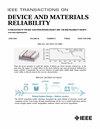纳米级CMOS低成本三节点扰流自恢复锁存器设计
IF 2.3
3区 工程技术
Q2 ENGINEERING, ELECTRICAL & ELECTRONIC
IEEE Transactions on Device and Materials Reliability
Pub Date : 2025-04-16
DOI:10.1109/TDMR.2025.3561519
引用次数: 0
摘要
由于半导体特征尺寸的不断减小,电荷共享效应越来越差。在纳米数字电路中,三节点扰动(TNU)的发生概率越来越高,对电路的可靠性有重要影响。本文提出了一种基于28纳米CMOS技术的低开销TNU自恢复锁存器(TNU- sr),以有效地容忍TNU,降低锁存器的功耗和延迟。本文提出的锁存器设计采用堆叠晶体管,以减少敏感节点和面积开销。TNU-SR锁存器采用时钟门控和高速传输路径技术,低功耗和低延迟。仿真结果表明,与现有锁存器相比,TNU-SR锁存器在延迟、功耗、面积等方面都有较好的性能,是空间应用抗辐射设计的理想选择。此外,与最新的TNU自恢复锁存器(HLTNURL)相比,本文提出的TNU- sr锁存器将功率-面积延迟积(PADP)度量降低了111.13%。本文章由计算机程序翻译,如有差异,请以英文原文为准。
A Low Cost Triple-Node-Upset Self-Recoverable Latch Design for Nanoscale CMOS
Due to the constant reduction of semiconductor feature sizes, the charge sharing effect is getting worse. The occurrence probability of triple-node upset (TNU), which has a significant impact on the circuit’s reliability, is rising in nanoscale digital circuits. This paper proposes a low overhead and TNU self-recovery latch (TNU-SR) based on the 28 nm CMOS technology to efficiently tolerate TNU and reduce the power dissipation and latency of the latch. The latch design proposed in this article adopts stacked transistors to reduce sensitive nodes and area overhead. The TNU-SR latch uses clock gating and high-speed transfer path technology, resulting in low power dissipation and low delay. For simulation results, compared with existing latches, it can be known that the TNU-SR latch performs well in terms of delay, power consumption, and area, so it is a good choice for radiation-hardened design for space applications. In addition, compared with the latest TNU self-recovery latch (HLTNURL), the TNU-SR latch proposed in this paper reduces the Power-Area-Delay Product (PADP) metric by 111.13%.
求助全文
通过发布文献求助,成功后即可免费获取论文全文。
去求助
来源期刊

IEEE Transactions on Device and Materials Reliability
工程技术-工程:电子与电气
CiteScore
4.80
自引率
5.00%
发文量
71
审稿时长
6-12 weeks
期刊介绍:
The scope of the publication includes, but is not limited to Reliability of: Devices, Materials, Processes, Interfaces, Integrated Microsystems (including MEMS & Sensors), Transistors, Technology (CMOS, BiCMOS, etc.), Integrated Circuits (IC, SSI, MSI, LSI, ULSI, ELSI, etc.), Thin Film Transistor Applications. The measurement and understanding of the reliability of such entities at each phase, from the concept stage through research and development and into manufacturing scale-up, provides the overall database on the reliability of the devices, materials, processes, package and other necessities for the successful introduction of a product to market. This reliability database is the foundation for a quality product, which meets customer expectation. A product so developed has high reliability. High quality will be achieved because product weaknesses will have been found (root cause analysis) and designed out of the final product. This process of ever increasing reliability and quality will result in a superior product. In the end, reliability and quality are not one thing; but in a sense everything, which can be or has to be done to guarantee that the product successfully performs in the field under customer conditions. Our goal is to capture these advances. An additional objective is to focus cross fertilized communication in the state of the art of reliability of electronic materials and devices and provide fundamental understanding of basic phenomena that affect reliability. In addition, the publication is a forum for interdisciplinary studies on reliability. An overall goal is to provide leading edge/state of the art information, which is critically relevant to the creation of reliable products.
 求助内容:
求助内容: 应助结果提醒方式:
应助结果提醒方式:


